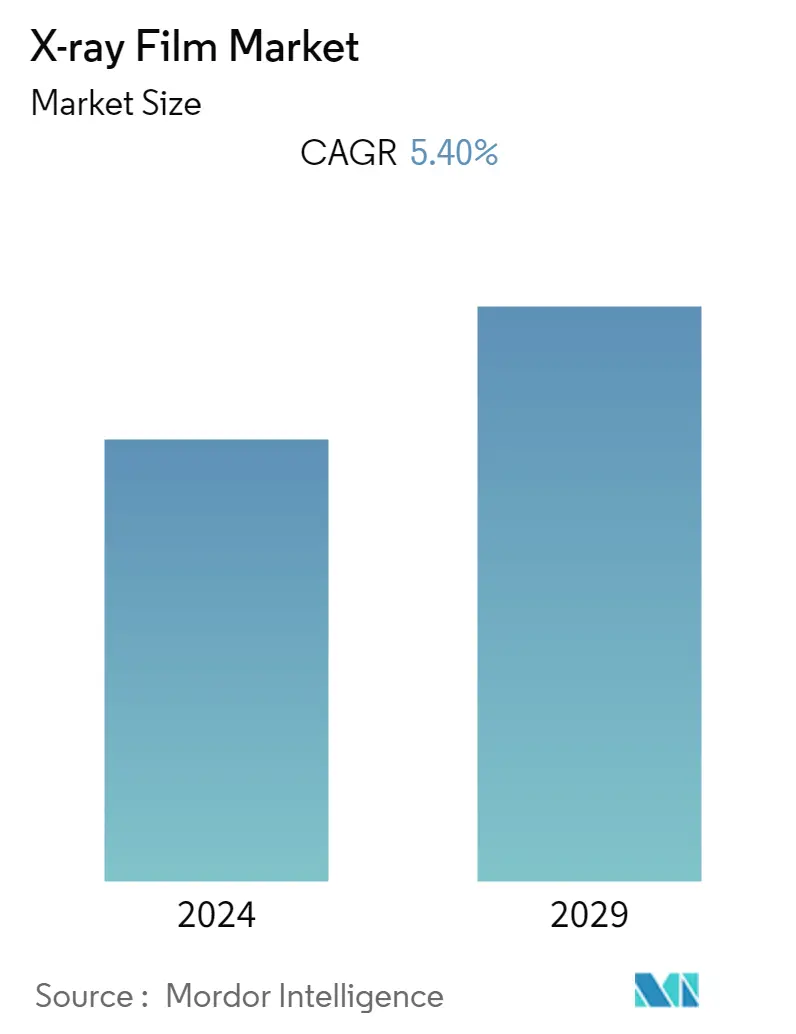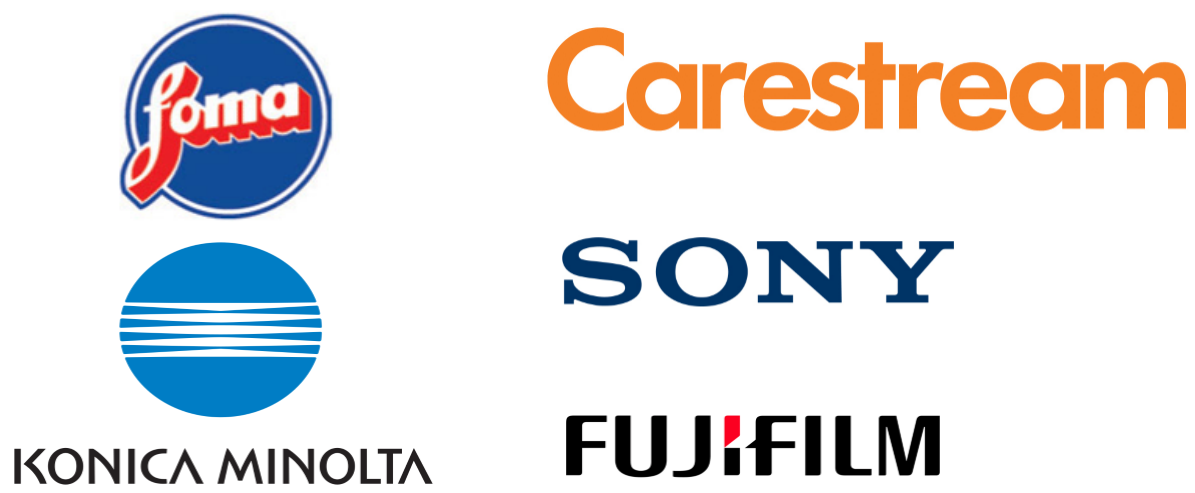Market Size of X-ray Film Industry

| Study Period | 2019 - 2029 |
| Base Year For Estimation | 2023 |
| CAGR | 5.40 % |
| Fastest Growing Market | Asia Pacific |
| Largest Market | North America |
| Market Concentration | Medium |
Major Players
*Disclaimer: Major Players sorted in no particular order |
X-ray Film Market Analysis
The X-ray film market is expected to register a CAGR of 5.4% over the forecast period 2021-2026. The continued adoption of traditional X-ray equipment in developing economies will drive the market in the forecast period.
- The growing occurrence of chronic diseases, coupled with the rising number of diagnostic imaging procedures and significant spending on healthcare across the world, has been instrumental in driving the medical X-ray market.
- X-ray techniques have been useful in the detection treatment of neurological problems, cancer, cardiac diseases, and bone-related problems. This has buoyed the adoption of X-ray equipment, and consequently the use of X-ray films.
- The strong consumer base in India and China, and the ageing population and the increasing demand for medical care have been instrumental in driving the market studied. However, over the forecast period, the establishment of new hospitals and medical facilities are expected to be in favour of the adoption of digital X-ray equipment, owing to the several benefits offered by them.
- Radiography in the medical field is undergoing a significant transition away from film and toward digital flat-panel detector technology(FDP), that has proved to be more affordable and efficient. With innovations, recent trends show that digital radiography over conventional systems is more effective in terms of image quality, further eliminating the need for X-ray films, chemicals, and darkroom setup, and thereby, improving the workflow and throughout.
X-ray Film Industry Segmentation
A medical X-ray film processor is the most important part of X-ray image processing. These processors are used to decipher the information carried by weakened X-ray beams when they are passed through tissues. They capture the invisible image and convert it into a visible form. The main part of an X-ray film is a radiation-sensitive, photographically active material made in the form of emulsion quoted on the supporting material called base.
| By End User | |||||
| |||||
| Industrial | |||||
| Other End Users |
| Geography | |
| North America | |
| Europe | |
| Asia-Pacific | |
| Latin America | |
| Middle East & Africa |
X-ray Film Market Size Summary
The X-ray film market is poised for growth, driven by the ongoing use of traditional X-ray equipment in developing regions. This growth is largely attributed to the increasing prevalence of chronic diseases and the rising number of diagnostic imaging procedures, alongside substantial healthcare investments globally. X-ray techniques are crucial for diagnosing and treating various medical conditions, including neurological issues, cancer, and bone-related disorders, which has spurred the demand for X-ray films. The expanding consumer base in countries like India and China, coupled with an aging population and heightened medical care demands, further propels market expansion. However, the shift towards digital X-ray equipment, due to its numerous advantages, is anticipated to influence market dynamics over the forecast period.
In the Asia-Pacific region, the reliance on traditional X-ray solutions remains significant, driven by a growing patient population requiring diagnostic imaging. Despite the slow transition to digital radiography compared to other regions, the demand for medical imaging continues to rise, contributing to the market's rapid growth. The region's healthcare infrastructure, particularly the increasing number of hospitals in countries like China, plays a vital role in this demand. The market is characterized by moderate competition, with key players such as Carestream, Sony, Fujifilm, and Konica Minolta, although innovation has been relatively slow. The market's evolution is shaped by both public and private sector investments, with developing economies seeing substantial private sector involvement in diagnostic imaging advancements.
X-ray Film Market Size - Table of Contents
-
1. MARKET DYNAMICS
-
1.1 Market Overview
-
1.2 Introduction to Market Drivers and Restraints
-
1.3 Market Drivers
-
1.3.1 Continued Adoption of Traditional X-ray Equipment in Developing Economies
-
-
1.4 Market Restraints
-
1.4.1 Emergence of Digital Radiography and Flat Panel Detector Technology
-
-
1.5 Industry Value Chain Analysis
-
1.6 Industry Attractiveness - Porter's Five Force Analysis
-
1.6.1 Threat of New Entrants
-
1.6.2 Bargaining Power of Buyers/Consumers
-
1.6.3 Bargaining Power of Suppliers
-
1.6.4 Threat of Substitute Products
-
1.6.5 Intensity of Competitive Rivalry
-
-
-
2. MARKET SEGMENTATION
-
2.1 By End User
-
2.1.1 Medical
-
2.1.1.1 Diagnostic Centers
-
2.1.1.2 Hospitals
-
2.1.1.3 Research and Educational Institutions
-
-
2.1.2 Industrial
-
2.1.3 Other End Users
-
-
2.2 Geography
-
2.2.1 North America
-
2.2.2 Europe
-
2.2.3 Asia-Pacific
-
2.2.4 Latin America
-
2.2.5 Middle East & Africa
-
-
X-ray Film Market Size FAQs
What is the current X-ray Film Market size?
The X-ray Film Market is projected to register a CAGR of 5.40% during the forecast period (2024-2029)
Who are the key players in X-ray Film Market?
Carestream Health Inc., Sony Corporation, Fujifilm Corporation, Foma Bohemia Ltd. and Konica Minolta Inc. are the major companies operating in the X-ray Film Market.

